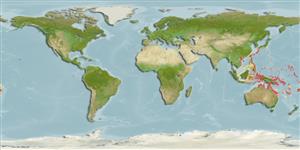>
Gobiiformes (Gobies) >
Gobiidae (Gobies) > Gobionellinae
Etymology: Redigobius: Latin,. Redere = to come back + Latin, gobius = gudgeon.
More on author: Herre.
Environment: milieu / climate zone / depth range / distribution range
Ecologie
marien; zoet water; brak water benthopelagisch; dH range: ? - 8; amfidroom (Ref. 59012); diepte 0 - 5 m (Ref. 86942). Tropical; 25°C - 28°C (Ref. 2060)
Asia: Sri Lanka, Philippines, Malaysia and Indonesia (Ref. 13235); Japan (Ref.43239). Oceania: New Guinea. Reported from New Caledonia (Ref. 13235), Micronesia (Ref. 59012). Africa: Mozambique. Indian Ocean: Madagascar, Mayotte (Ref. 55749).
Grootte / Gewicht / Leeftijd
Maturity: Lm ? range ? - ? cm
Max length : 3.8 cm SL mannelijk / geslacht onbekend; (Ref. 44894)
Korte beschrijving
Determinatiesleutels | Morfologie | Morfometrie
Dorsale stekels (totaal) : 7; Dorsale zachte stralen (totaal) : 6 - 7; Anale stekels: 1; Anale zachte stralen: 6. Distinguished by the following characteristics: moderate-sized Redigobius; single black band extending down and back from tip of first dorsal fin; distinct black band extending from eye diagonally across opercle to lower edge of pectoral fin base; first dorsal fin tall and elongate, third or fourth spine longest; opercle with small ctenoid scales; 14 circumpeduncular scales; second dorsal rays modally I,7; anal rays I,6; pectoral rays 16-17; longitudinal scales 23-25; TRB 9-11; predorsal scales 9-12 (Ref. 84480).
Adults inhabit coastal estuaries, lakes (Ref. 48637), and entering lower reaches of freshwater streams (Ref. 44894). Also found in quiet mangrove estuarine habitats (Ref. 84480). Also Ref. 43716.
Levenscyclus en paargedrag
Maturities | Voortplanting | Spawnings | Egg(s) | Fecundities | Larven
Keith, P., G. Marquet, P. Valade, P. Bosc and E. Vigneux, 2006. Atlas des poissons et des crustacés d'eau douce des Comores, Mascareignes et Seychelles. Muséum national d’Histoire naturelle, Paris. Patrimoines naturels, 65:250p. (Ref. 57749)
Status op de Rode Lijst van het IUCN (Ref. 130435)
Gevaar voor de mens
Harmless
Gebruik door de mens
Tools
Speciale rapporten
Download XML
Internetbronnen
Estimates based on models
Preferred temperature (Ref.
123201): 25.4 - 29.3, mean 28.6 °C (based on 1307 cells).
Fylogenetische diversiteitsindex (Ref.
82804): PD
50 = 0.5000 [Uniqueness, from 0.5 = low to 2.0 = high].
Bayesian length-weight: a=0.00977 (0.00442 - 0.02163), b=3.05 (2.86 - 3.24), in cm total length, based on LWR estimates for this (Sub)family-body shape (Ref.
93245).
Trofisch niveau (Ref.
69278): 3.3 ±0.4 se; based on size and trophs of closest relatives
Weerstandsvermogen (Ref.
120179): Hoog, minimale populatieverdubbelingstijd minder dan 15 maanden (Preliminary K or Fecundity.).
Fishing Vulnerability (Ref.
59153): Low vulnerability (10 of 100).
